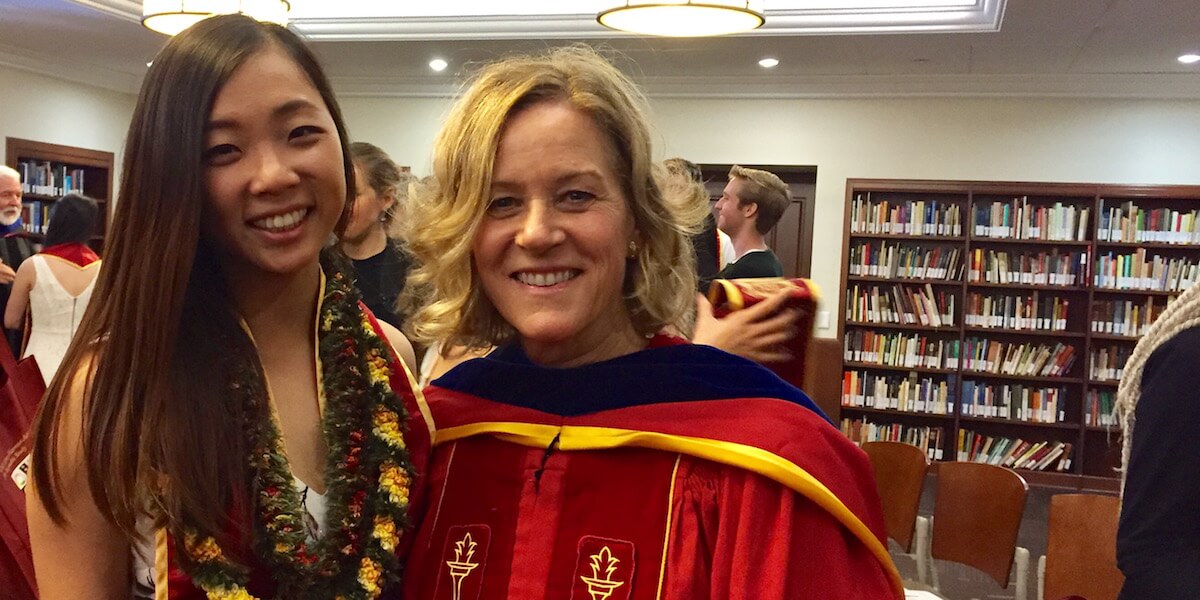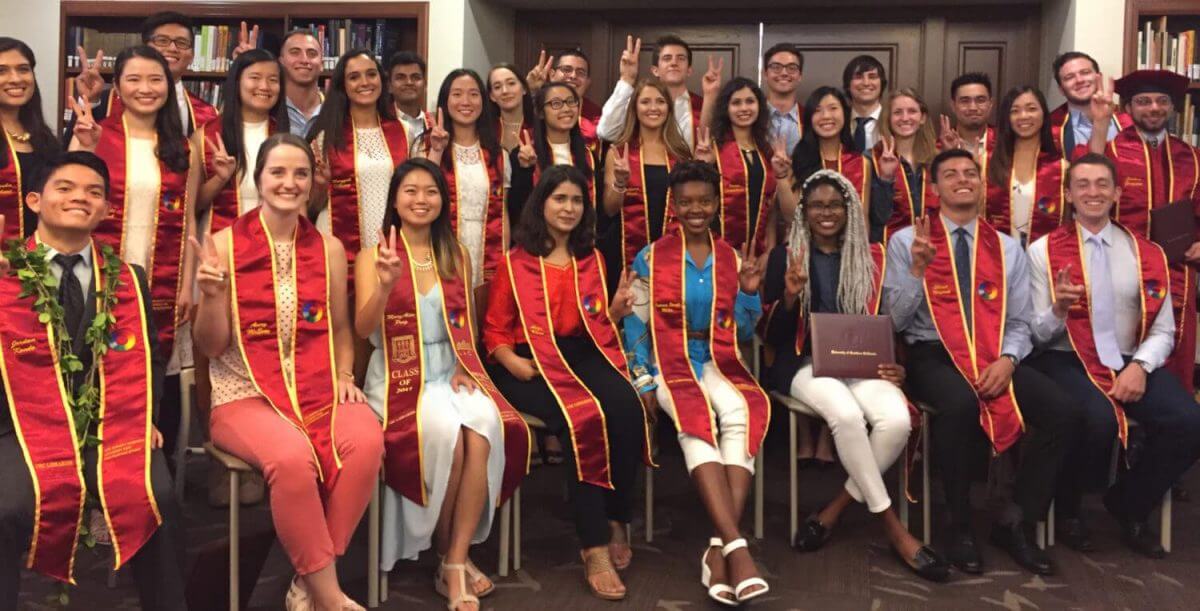
By Naomi Yau
I learned a lot during my four years at USC. But perhaps the most important thing I learned was the value of a truly diverse education. Dr. Karen Huebner, one of my mentors here, once told me, “There’s not a single problem in the world that can be solved with only one discipline.” Dr. Huebner is the Director of the Sidney Harman Academy for Polymathic Study at USC. This institution, along with my home department of electrical engineering, helped open my eyes to the endless opportunities engineering students have to change the world.
The word for someone with a wide range of learning or interests is “polymath”. The irony is that in a world where different fields of study overlap more than ever before, students are sometimes encouraged to take a narrower and narrower approach to their own education.

Naomi, who loves music, with an electric guitar she built EE202 – an electrical engineering course on linear circuits.
As a polymath, I chose engineering because it was the best lens through which to understand many things I’m passionate about: community, problem-solving, math, music, fitness, physics, technology, and more. I chose electrical engineering because the broad major most easily grounded my diverse interests. Although it may sound like I always knew what direction I’d go in, it took many years for me to realize what path was right for me. And isn’t that what college is all about anyway?
At USC, I was exposed to so many new things – engineering, yoga, orchestra, nutrition and the GE curriculum. More importantly, I found exciting connections between all these courses. Whether it be engineering sound systems to capture full orchestral harmonies or food technology to optimize the best nutrients in food, these connections surprised me by how fundamentally rooted they were in technology and engineering. In the electrical engineering department itself, I discovered courses that allowed for multi-dimensional applications as well.
In the fall of my sophomore year, still trying to find my way, I took a semester off and accepted an internship at Healthways Hawaii. This further expanded my horizons and opened my eyes to the world of healthcare, which I became fascinated with. I loved the way something as small as a follow-up visit could make a significant difference in someone’s life. The importance of health never dawned on me until I saw firsthand the frustrations of a man struggling with obesity and unable to connect with his family.
With this new realization, I began taking classes at USC that supported my interests in technology and healthcare. From introductory nutrition classes like GERO411L with Professor Cary Kreutzer to high level analog circuit designs like EE479 with Professor SungWon Chung, I saw endless possibilities for improving technologies to benefit the health field.
I now approached my EE classes from the perspective of an aspiring healthcare professional. I suddenly noticed all the practical uses for electrical device improvements, power development in circuit boards designs and even software computing efficiency. These small technological enhancements play a large part in improving healthcare and in closing the world’s health gaps. If only more students could be encouraged to see the overlaps within different disciplines! I was constantly looking for ways to problem-solve health issues by engineering new technology or improving existing technology.
Through my classes, internships, and discussions with faculty and friends on campus, I had identified the general direction I wanted to go in. The Polymathic Academy helped me focus my many passions into a detailed plan for my future. The academy is an open place for students who have interests and skills in multiple disciplines. Faculty, scholars, graduate, and undergraduate students all come together around presentations and discussions meant to improve our awareness of how our diverse interests coincide in the real world.
“I want students to know that experience in another field can be incredibly beneficial to the work you’re doing in engineering.”
Before I became involved, I was concerned that my work and internships during college wouldn’t translate to the type of career I wanted. I also struggled to clearly explain to others (and to myself!) how my varied interests could best align with the specialized technical positions that companies often look for. I wasn’t even sure companies valued well-roundedness as much high schools and colleges do.
The polymathic academy, along with supportive professors in my department, helped guide me through those times and confirmed my belief in the value of interdisciplinary work. I eventually saw how my diverse background with an engineering focus made me a desirable candidate for many jobs. This was a hugely liberating and justifying experience. I only wish I had discovered it earlier and I encourage every student who values interdisciplinary studies to check it out.
My love of engineering and healthcare has led me to become an engineering member of Kaiser Permanente’s Innovations Team. Here, I’m getting a chance to use my experience in these integrated disciplines. My advice to current or aspiring students is to realize that electrical engineering touches almost every aspect of the world you can imagine. I also want students to know that experience in another field can be incredibly beneficial to the work you’re doing in engineering. No matter what your passion is, there is a place for it in this department.
Naomi Yau is a 2017 EE graduate and member of the USC polymathic institute. Her love for working with professors from different schools expands outside of the classroom from projects and volunteer work to planning student retreats. Starting this July, she will be joining Kaiser’s Innovations Team, working with health innovative projects specific to technology in healthcare.

Naomi (middle row, second from right) with the rest of the 2017 Sidney Harmon Academy for Polymathic Study Graduates
Published on June 15th, 2017
Last updated on April 7th, 2021

